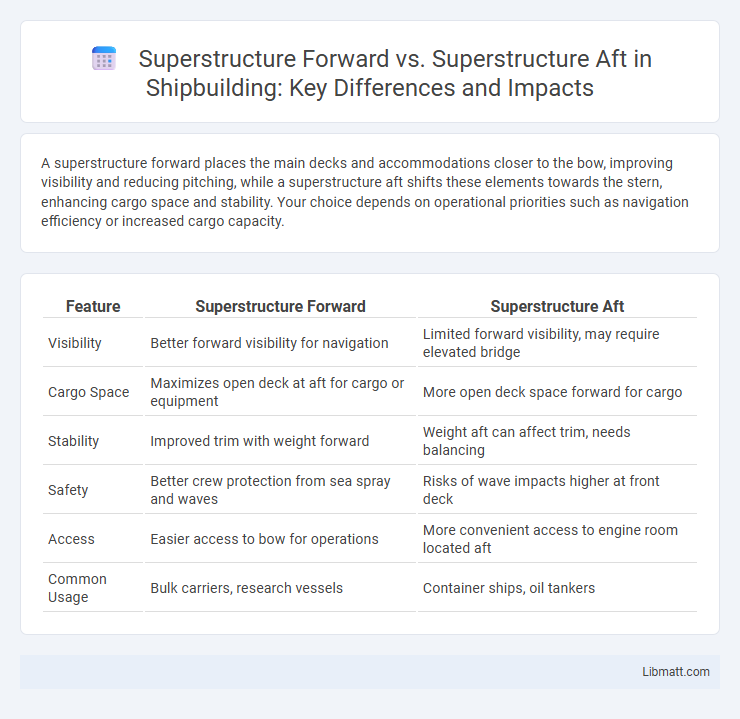A superstructure forward places the main decks and accommodations closer to the bow, improving visibility and reducing pitching, while a superstructure aft shifts these elements towards the stern, enhancing cargo space and stability. Your choice depends on operational priorities such as navigation efficiency or increased cargo capacity.
Table of Comparison
| Feature | Superstructure Forward | Superstructure Aft |
|---|---|---|
| Visibility | Better forward visibility for navigation | Limited forward visibility, may require elevated bridge |
| Cargo Space | Maximizes open deck at aft for cargo or equipment | More open deck space forward for cargo |
| Stability | Improved trim with weight forward | Weight aft can affect trim, needs balancing |
| Safety | Better crew protection from sea spray and waves | Risks of wave impacts higher at front deck |
| Access | Easier access to bow for operations | More convenient access to engine room located aft |
| Common Usage | Bulk carriers, research vessels | Container ships, oil tankers |
Introduction to Ship Superstructures
Ship superstructures include all above-deck structures such as the bridge, accommodations, and crew facilities, with forward and aft configurations serving distinct operational purposes. Forward superstructures typically house navigation and control centers for improved visibility, while aft superstructures prioritize crew living spaces and machinery access. Proper placement of these superstructures significantly influences vessel stability, cargo operations, and overall ship performance.
Defining Forward vs Aft Superstructures
Forward and aft superstructures refer to the locations of elevated structures on a ship's deck, with the forward superstructure positioned toward the bow and the aft superstructure placed near the stern. The forward superstructure typically houses the bridge and navigation equipment, enabling optimal visibility for ship operation, while the aft superstructure often contains living quarters and machinery spaces. Understanding the distinct roles and placements of these superstructures is crucial for effective ship design and operational functionality.
Historical Evolution of Superstructure Placement
Superstructure forward placement originated in early naval ship designs to enhance forward visibility for navigation and combat, reflecting tactical priorities of the 19th and early 20th centuries. Superstructure aft became prominent with advances in shipbuilding, centralizing control and accommodation areas to protect vital sections and improve stability during World War II. Modern naval architecture often balances these configurations, integrating technological advancements while preserving operational efficiency and crew safety.
Key Design Differences: Forward vs Aft
Superstructure forward designs prioritize enhanced visibility and easier access to navigation equipment, often featuring a streamlined profile to reduce wind resistance. Superstructure aft layouts emphasize increased deck space and improved cargo handling efficiency, positioning living quarters and operational centers toward the rear. These key design differences impact vessel stability, crew comfort, and functional usage based on the specific maritime application.
Impact on Ship Stability and Performance
Superstructure forward shifts the ship's center of gravity towards the bow, potentially increasing pitching motions and affecting seaworthiness in rough seas. Superstructure aft concentrates weight towards the stern, which can improve trim and reduce resistance, enhancing fuel efficiency and speed. Your ship's overall stability and handling characteristics depend significantly on the superstructure placement in relation to hull design and load distribution.
Visibility and Navigational Advantages
Superstructure forward design offers improved forward visibility, essential for better navigation and obstacle detection, enhancing safety during vessel operation. Superstructure aft provides superior aft visibility, beneficial when docking or maneuvering in tight spaces, allowing for more precise control. Your choice between these configurations should align with the specific navigational priorities and operational environments of your vessel.
Influence on Cargo Handling and Deck Layout
Superstructure forward designs centralize crew accommodations and navigation spaces at the bow, freeing extensive aft deck space for cargo operations and maximizing deck layout efficiency. In contrast, superstructure aft configurations allocate more deck area at the bow, which can complicate cargo handling due to longer transit distances and potential obstructions. Your vessel's cargo handling efficiency and deck layout should be evaluated based on superstructure placement to optimize operational workflows and safety.
Operational and Safety Considerations
Superstructure forward enhances visibility and maneuverability, crucial for navigating tight waterways and busy ports, while superstructure aft improves cargo handling efficiency by maximizing deck space. Operational safety is impacted by the superstructure placement, as forward positioning reduces the risk of collision during front-end operations, whereas aft superstructures lower the center of gravity, contributing to better vessel stability. Your choice between these configurations should weigh navigational demands against cargo operations to optimize overall safety and effectiveness.
Common Ships with Forward or Aft Superstructures
Common ships with superstructures forward include container ships and some bulk carriers, designed for enhanced visibility and optimal cargo handling. Vessels like oil tankers and certain research ships often feature aft superstructures, improving engine room access and stability. Your choice between forward or aft superstructure influences ship performance, operational efficiency, and crew comfort based on specific maritime needs.
Future Trends in Superstructure Placement
Superstructure forward placement enhances visibility and reduces aerodynamic drag, which is increasingly favored in modern ship design for improved fuel efficiency and safety. Superstructure aft remains popular for cargo ships due to better weight distribution and easier engine access, but new hybrid layouts are emerging to optimize operational performance. You should consider future trends emphasizing environmental regulations and advanced materials that influence the evolving balance between superstructure forward and aft configurations.
Superstructure forward vs superstructure aft Infographic

 libmatt.com
libmatt.com